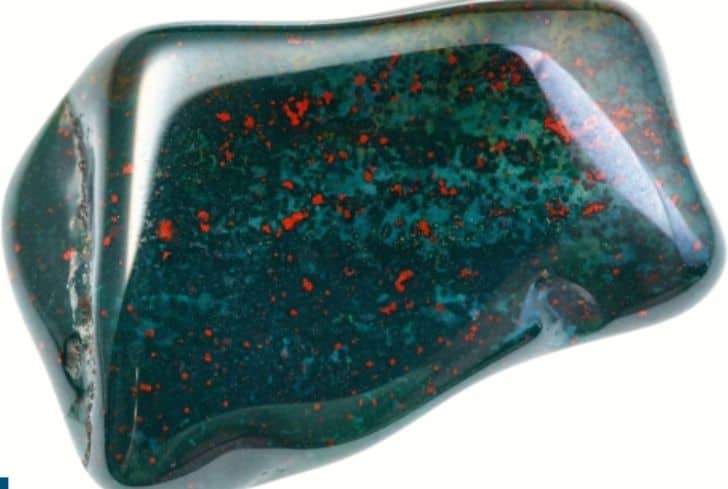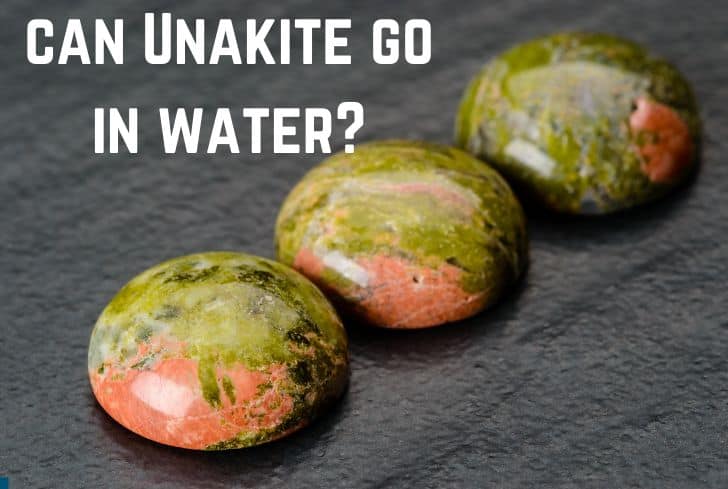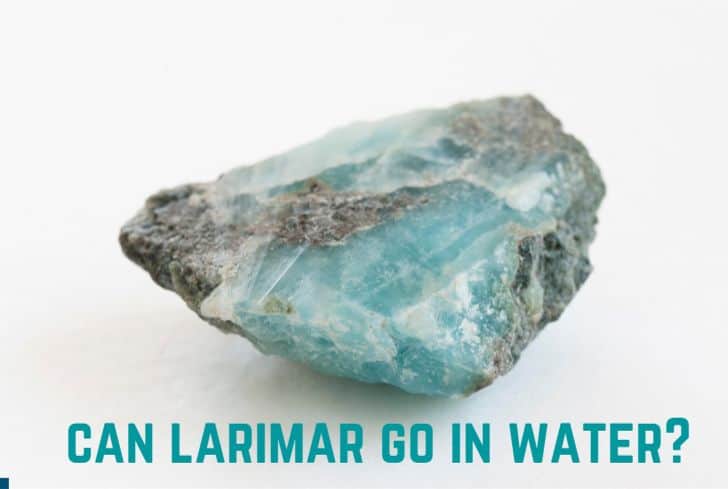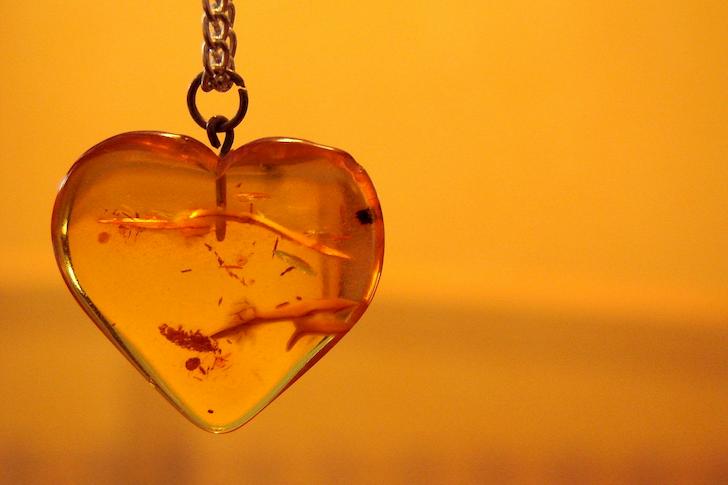Can Bloodstone go in the Water? (And in the Sun?)

Bloodstone is another name for heliotrope, which is a cryptocrystalline mixture of quartz that is mostly jasper or chalcedony. The most popular Bloodstone is opaque green jasper having red inclusions of hematite. The red inclusions look like spots of blood, which is why the stone is called Bloodstone.
In this article, we are going to find out if Bloodstone can go in water. We will look at the properties of Bloodstone and its interaction with sunlight and salt. We will talk about the common beliefs associated with the stone. Finally, we will learn about taking care of it.
Is Bloodstone Water Safe?
Yes, Bloodstone is water safe. It has a hardness of 6.5-7 on the Mohs Hardness Scale, meaning that it can survive underwater. But, as with all stones, they should not be immersed for too long, as they can damage the stone. Moreover, Bloodstone contains hematite, which is an iron oxide and can get rusted.
Mohs Hardness Scale measures the relative resistance of a mineral to scratching. It is a good indicator of a mineral’s interaction with water. A value above 5.0 on the Mohs scale implies that the mineral is safe underwater.
Since Bloodstone’s value is 6.5-7, it can go into the water. But, since Bloodstone contains hematite, a common iron oxide, putting it in water for a long time is not a great idea. Water is a catalyst in the rusting process, as it allows iron to react by breaking up the oxygen molecule.
In general, letting stones immersed in water for a long duration is not recommended. Water can get into the crevices of the stone and widen them, thus damaging its structure. They also tend to fade out the color and lustre of the stone.

What are the Properties of Bloodstone?
These are the properties of bloodstone:
- Cryptocrystalline: Bloodstone is cryptocrystalline, meaning that it is made up of extremely minute crystals. Its crystalline structure is only visible by the use of a polarizing microscope.
- Colour: The most popular bloodstone is opaque and has a dark green body. It has red to orange spots, which resemble spots of blood, hence the name bloodstone. The stone usually has a dull to vitreous lustre.
- Inclusions: The red spots on the bloodstone are caused by the presence of iron oxides like hematite. The stone also has inclusions of actinolite or hornblende needles.
- Hardness: Bloodstone has a value of 6.5-7.0 on the Mohs scale, meaning that it is a rather hard stone. It is quite resistant to scratching and is safe underwater, but it should not be immersed for long.
- Structure: Bloodstone’s chemical formula is SiO2, and it has a trigonal crystal system. Bloodstone does not have a cleavage, meaning that there is no break in it along the internal planes.
What Does Bloodstone Symbolize?
Due to its unique appearance, bloodstone has always been associated with many beliefs. In the Middle Ages, Christians associated the stone with the Crucifixion, suggesting that the red spots come from Jesus’ blood. Bloodstone has also come to stand for bravery and vitality because of its blood-like texture.
Bloodstone is considered the birthstone of March, the month named after the Roman god of war, mars. Ancient Roman soldiers believed that could slow bleeding. Both Greeks and Romans wore it in hopes of getting renown and success in their games.
It is also believed that the stone can stop bleeding when placed on injuries. This might have a scientific basis because the stone contains iron oxide, which is a good astringent. This just goes to show how some popular beliefs may also be linked to science.
Can Bloodstone go in the Sun?
Yes, Bloodstones can go in the sun. With a value of 6.5-7 on the Mohs scale, it is quite a hard stone and will be safe in sunlight. Recharging stones in sunlight is a popular method, but you should not leave them out for too long as that can fade and tarnish the stone.
It is fine to keep the Bloodstone out in the sun for a short duration, say 2-3 hours. A longer duration can dull the stone’s surface or damage it. For better protection, it’s best to keep your stone behind a window, so that the glass acts as a protective layer.
Try leaving your stone out when the sunlight is gentle, like during morning hours. You can also try other methods of recharging the stone such as keeping it in moonlight, burying it, etc.
Bloodstone has another special relationship to the sun, as its other name is heliotrope. It is derived from Greek, where “helio” means “sun” and “trope” means “turning”. This name comes from ancient beliefs about the way light is reflected from the stone.
Roman historian Pliny the Elder wrote that the stone gives a red reflection when turned to sunlight while being immersed in water. Some people like Damigeron connected this to another natural phenomenon, suggesting that the stone can make solar eclipses happen.
Can Bloodstone go in Salt?
Yes, bloodstones can go in the salt. It has a value of 6.5-7 on the Mohs scale, meaning that it is not easily scratched by other surfaces. Keeping a stone on a bed of dry salt is a common method of recharging it. However, you should not put bloodstone into saltwater as it can damage the stone.
While bloodstone’s hardness is good enough to withstand water, it should nevertheless not be immersed in water for long. The presence of iron oxides like hematite inside the stone makes it prone to rusting, which can ruin the appearance of the stone.
When we are dealing with salt water, things get even worse. Water has the potential to enter the crevices of the stone, and even after it evaporates, the salt remains. These particles can expand the cracks within the stone, damaging its structure.
How Can You Tell if a Bloodstone is Real?
Bloodstone’s hardness and unique color make it an excellent choice for jewelry. However, some sellers might try to cheat you by passing off some other stone as Bloodstone. To check the authenticity of the stone, keep the following points in mind:
- Streak Check: Bloodstone has distinctive red spots on its surface due to the presence of hematite. If you rub the stone against porcelain, you should see the residue of red scars. If you don’t see this, you might be dealing with something other than a real Bloodstone.
- Colour: Usually bloodstone is a dark green gemstone with spots of red. Have a look at pictures of bloodstones on the internet and you will have a good standard to judge stones in real life. The number of spots determines the price of the stone, so ensure that the price is proportionate to the number of spots.
- Scratch Test: Bloodstone has a value of 6.5-7 on the Mohs Hardness Scale, meaning that it is quite resistant to scratching. A metallic nail will help you do a scratch test and see if it is a real Bloodstone.
Glass pieces have the potential to mimic bloodstone’s colors. But despite appearances, these pieces made up of glass are very different from real bloodstones. Through microscopic analysis, one can find that the “flowers” present in glass imitations are not the same as bloodstone spots.
How to Clean and Take Care of Bloodstone?
Bloodstone does not have cleavage, and it has a hardness of 6.5-7 on the Mohs scale. It also has a tough tenacity, meaning that it is quite resistant to physical blows. All these features make Bloodstone an excellent gemstone for jewelry.
But to ensure that the stone retains its beautiful color and spots, you must take proper care of it. Follow these steps to clean your Bloodstone:
- Mix a mild detergent with warm water.
- Take a soft cloth and soak it in the solution.
- Use the cloth to gently rub the surface of the bloodstone.
You can also try spraying mist around your stone and then wiping it off with a soft cloth. This reduces the chances of damaging the bloodstone by water.
As we have discussed, although bloodstone has a hardness of 6.5-7 on the Mohs Scale, the presence of iron oxides in it makes it prone to damage by prolonged exposure to water.
Because of its hardness and tough tenacity, bloodstone can also withstand mechanical cleaning. These include ultrasonic, steam, and boiling systems. These mechanical tools provide great results on gems that are difficult to clean and require minimal effort. However, these procedures should be done by professionals.
At home, it’s best to clean the stone using a detergent-water solution and a cloth.
Conclusion
In this article, we have discussed Bloodstone’s interaction with water. With a hardness of 6.5-7 on the Mohs scale, Bloodstone is safe in the water. However, it should not be immersed for long, as the presence of iron oxides makes it prone to rusting. We also looked at the stone’s interaction with sunlight and salt. Finally, we talked about verifying Bloodstone’s authenticity and cleaning it.






